
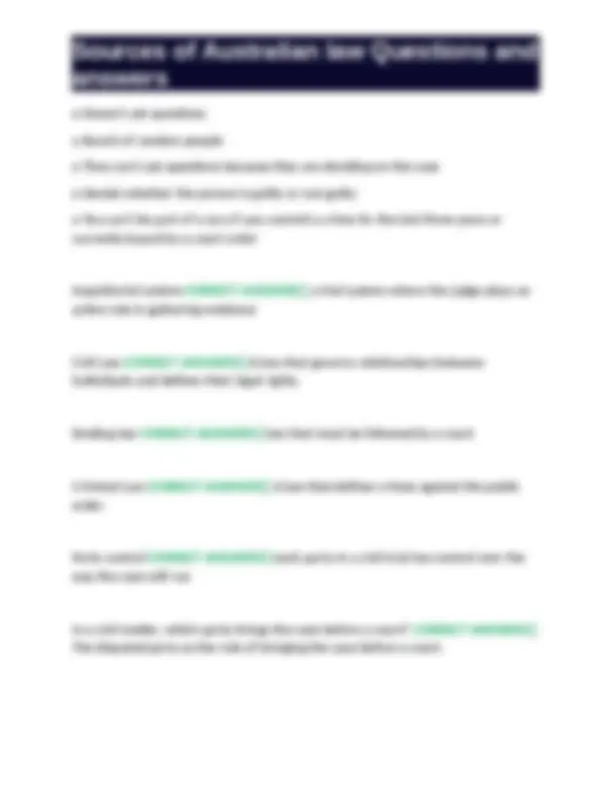

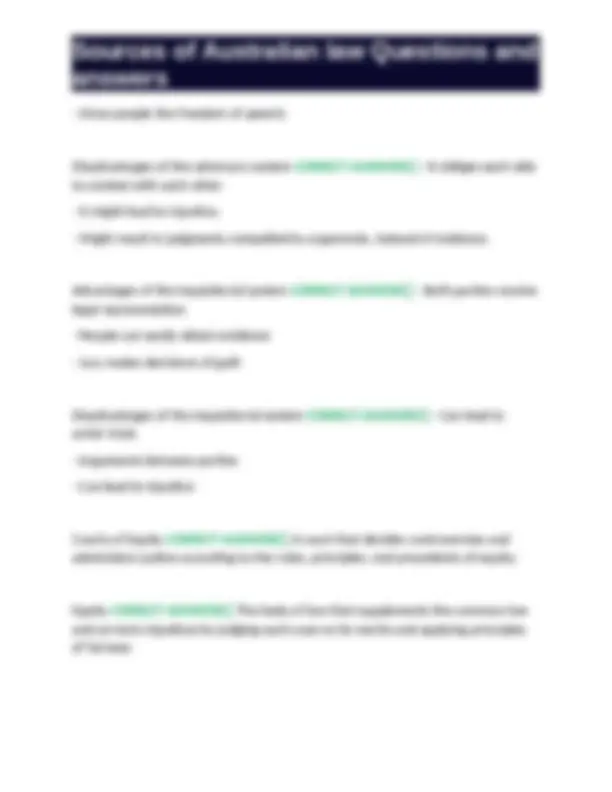
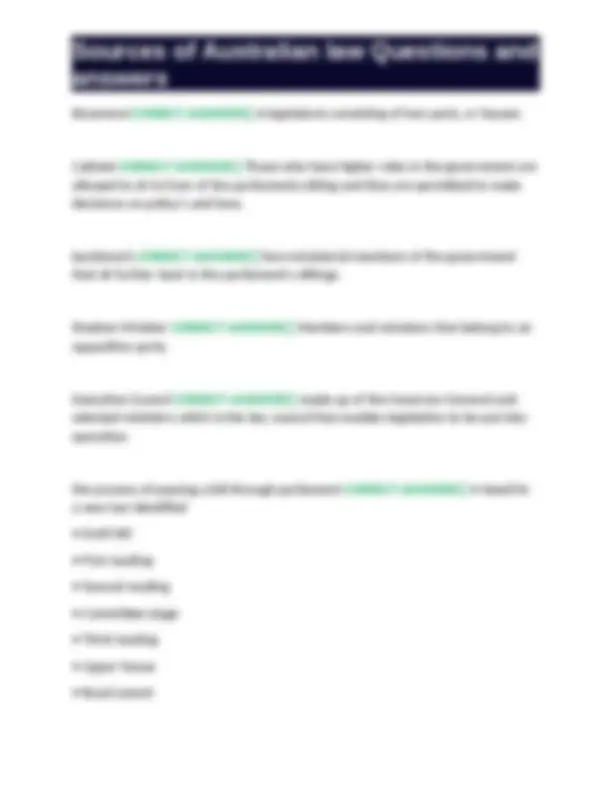

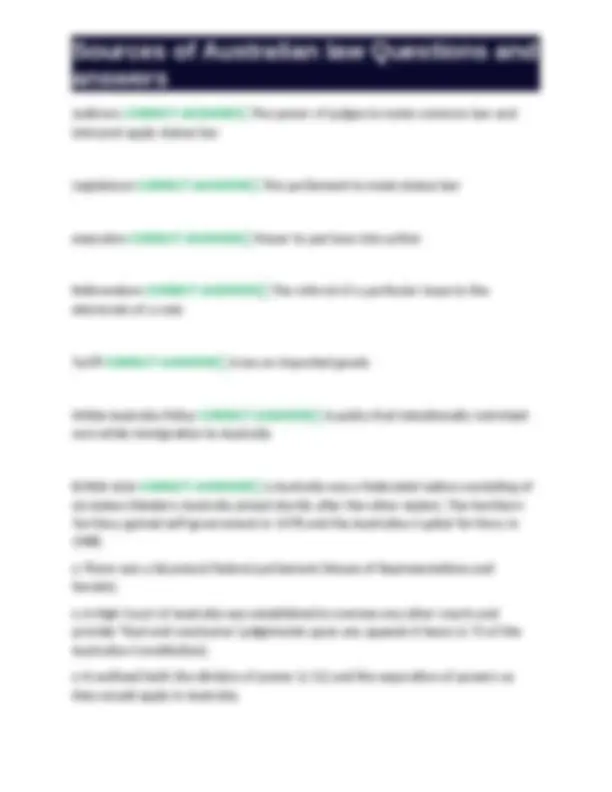
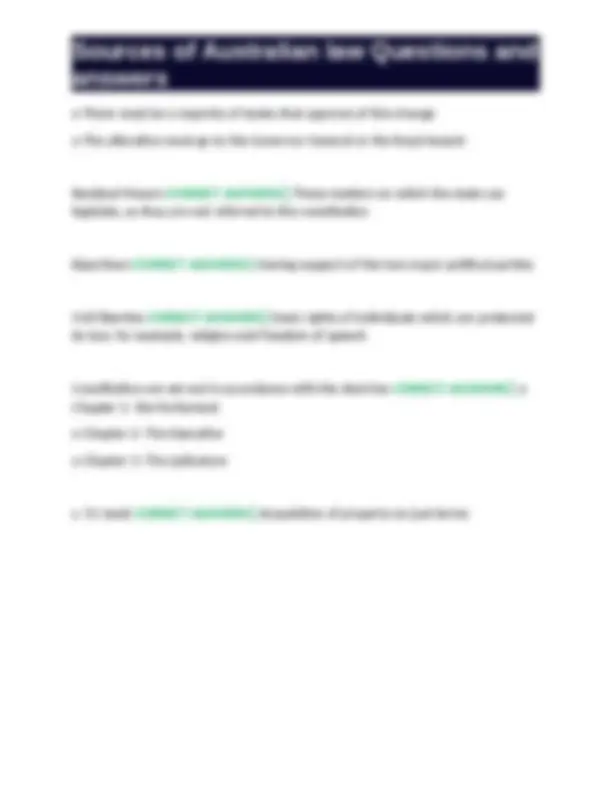


Study with the several resources on Docsity

Earn points by helping other students or get them with a premium plan


Prepare for your exams
Study with the several resources on Docsity

Earn points to download
Earn points by helping other students or get them with a premium plan
Community
Ask the community for help and clear up your study doubts
Discover the best universities in your country according to Docsity users
Free resources
Download our free guides on studying techniques, anxiety management strategies, and thesis advice from Docsity tutors
An overview of the australian legal system, including the sources of law, the role of judges, juries, and the house of representatives, and the differences between civil and criminal law. It also covers key concepts such as adversary system, inquisitorial system, jurisdiction, and the process of passing a bill through parliament.
Typology: Exams
1 / 13

This page cannot be seen from the preview
Don't miss anything!








Common Law CORRECT ANSWERS✅ A legal system based on custom and court rulings. Statue Law CORRECT ANSWERS✅ Law made by parliament. Precedent CORRECT ANSWERS✅ In a previous legal case that is either binding on or persuasive for a court or other tribunal when deciding subsequent cases with similar issues or facts. Trial be ordeal CORRECT ANSWERS✅ An ancient judicial practice by which the guilt or innocence of the accused was determined by subjecting them to a painful, or at least an unpleasant, usually dangerous experience. The test was one of life or death, and the proof of innocence was survival. Trial by combat CORRECT ANSWERS✅ An accused person had to fight to prove his/her innocence. Norman Conquest CORRECT ANSWERS✅ Sent justices around England to make sure the disputes were settled the same way everywhere in the country. The beginning of common law Doctrine of precedent CORRECT ANSWERS✅ The common-law principle by which the decisions of higher courts in a hierarchy are binding on lower courts in the same hierarchy where the material facts are similar. Court of Chancery CORRECT ANSWERS✅ Court that granted relief based on fairness. Also called equity court.
Plaintiff CORRECT ANSWERS✅ One who begins a lawsuit How the legal system basically works CORRECT ANSWERS✅ o A parliament passes a law o A person is charging with breaking the law o That person goes to court o The judge decides whether the words of that law apply to that person's actions. Rankings of the court CORRECT ANSWERS✅ - High Court
Role of the Judge in the adversary system CORRECT ANSWERS✅ To ensure a fair and balanced trial admissable evidence CORRECT ANSWERS✅ evidence that is acceptable to the court. e.g. Faulty goods, oral testimony , business records, photographic evidence inadmissible evidence CORRECT ANSWERS✅ evidence that is presented in court but is unrelated to the substance of the case. Standard of proof in a criminal case CORRECT ANSWERS✅ Proof beyond a reasonable doubt Standard of proof in a civil case CORRECT ANSWERS✅ preponderance of the evidence Why is there a need for legal representation? CORRECT ANSWERS✅ It could lead to unjust outcomes which could result with parties to self-represent or it could lead to one party's legal representation to become superior then the other party cause to become biased. What countries use the inquisitorial system of trial? CORRECT ANSWERS✅ France, Germany and the Netherlands Advantages of the adversary system CORRECT ANSWERS✅ - Fair justice and trial
committal hearings CORRECT ANSWERS✅ Inquiries held in the Local or Magistrates' Court to determine whether there is enough evidence against the defendant to warrant a trial in a higher court (this is called establishing a Prima facie case) Coronial Inquests CORRECT ANSWERS✅ investigations into deaths that have occurred in unusual circumstances, held in the Coroner's Court and overseen by a magistrate called the Coroner corporations law CORRECT ANSWERS✅ legislation that regulates corporations and the securities and futures industry in Australia; it is administered by the Australian Securities and Investments Commission (ASIC) Role of the House of Representatives CORRECT ANSWERS✅ o Form government o Considers bills o Debate matters of local electoral concern o Debate matters of national or constituent interest Senators CORRECT ANSWERS✅ o Consider recommendations of committees o Consider and vote on bills o Represent the interests of people in their states or territories o Proposes amendments to bills lower house CORRECT ANSWERS✅ The government sits on one side and the opposition and independents on the other
Bicameral CORRECT ANSWERS✅ A legislature consisting of two parts, or houses Cabinet CORRECT ANSWERS✅ Those who have higher roles in the government are allowed to sit in from of the parliaments sitting and they are permitted to make decisions on policy's and laws. backbench CORRECT ANSWERS✅ Non-ministerial members of the government that sit further back in the parliament's sittings. Shadow Minister CORRECT ANSWERS✅ Members and ministers that belong to an opposition party. Executive Council CORRECT ANSWERS✅ made up of the Governor-General and selected ministers which is the key council that enables legislation to be put into operation the process of passing a bill through parliament CORRECT ANSWERS✅ • Need for a new law identified
Judiciary CORRECT ANSWERS✅ The power of judges to make common law and interpret apply statue law Legislature CORRECT ANSWERS✅ The parliament to make statue law executive CORRECT ANSWERS✅ Power to put laws into action Referendum CORRECT ANSWERS✅ The referral of a particular issue to the electorate of a vote Tariff CORRECT ANSWERS✅ A tax on imported goods White Australia Policy CORRECT ANSWERS✅ A policy that intentionally restricted non-white immigration to Australia British Acts CORRECT ANSWERS✅ o Australia was a federated nation consisting of six states (Western Australia joined shortly after the other states). The Northern Territory gained self-government in 1978 and the Australian Capital Territory in
o There was a bicameral federal parliament (House of Representatives and Senate). o A High Court of Australia was established to oversee any other courts and provide 'final and conclusive' judgements upon any appeals it hears (s 73 of the Australian Constitution). o It outlined both the division of power (s 51) and the separation of powers as they would apply in Australia.
o It enabled the Constitution to be altered by a referendum (s 128 of the Australian Constitution). The federation process of the Australian constitution CORRECT ANSWERS✅ o The Senate provides a 'check' (restraint) on the power of the House of Representatives. All states have 12 number of senators while territories only have 2 o Section 128 covers the process for altering the Constitution, specifies that a majority of states need to vote 'yes' on a proposal for it to succeed; that is, four out of six states. It should be noted that this strict requirement has made constitutional change very difficult: no referendum has succeeded since 1977. o The division of power outlined in s 51 ensures that the states have control over the 'residual powers'; that is, those not listed in s 51. This will be examined in detail later in this chapter. Section 51 CORRECT ANSWERS✅ Federal Parliament has the power to make laws with respect to all the matters that are listed Commonwealth (federal) Parliament can legislate on CORRECT ANSWERS✅ o The seat of the government in the Commonwealth o Matters relating to any powers to any department of the public service o Other matters declared by the Constitution to be within the exclusive power of the Parliament. concurrent powers CORRECT ANSWERS✅ Existing at the same time; powers held by both states and federal parliaments
o There must be a majority of states that approve of this change o The alteration must go to the Governor General or the Royal Assent Residual Powers CORRECT ANSWERS✅ Those matters on which the state can legislate, as they are not referred to the constitution Bipartisan CORRECT ANSWERS✅ Having support of the two major political parties Civil liberties CORRECT ANSWERS✅ basic rights of individuals which are protected by law; for example, religion and freedom of speech Constitution are set out in accordance with the doctrine CORRECT ANSWERS✅ o Chapter 1- the Parliament o Chapter 2- The Executive o Chapter 3- The judicature s. 51 (xxxi) CORRECT ANSWERS✅ Acquisition of property on just terms